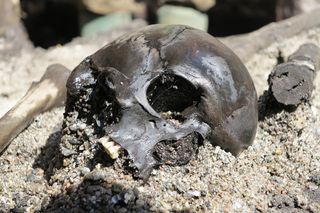Warriors' Bones Reveal Bizarre Iron Age Rituals

The bones of dozens of Iron Age warriors found in Denmark were collected and ritually mutilated after spending months on the battlefield, archaeologists say.
At least six months after the soldiers died, their bones were collected, scraped of remaining flesh, sorted and dumped in a lake. Some were handled in a truly bizarre manner; for instance, four pelvises were found strung on a stick.
"We think it's a kind of ritual closure of the war," said Mads Kähler Holst, project manager at the dig and head of the department of archaeology at the Moesgård Museum in Denmark. The victors seem to have carried out their gruesome work on a spit of land extending into the lake where the bones were dumped, the researchers said. [See Photos of the Mutilated Iron Age Skeletons]
Bog bodies
The site of the boneyard is in East Jutland, in a wetland area known as Alken Enge. Drainage work and peat digging have been turning up ancient human remains in this bog for decades, Holst told Live Science.

Formal excavation of the site finds it to be a mass grave dating back about 2,000 years, to the transition from B.C. to A.D. At the time, the area was about 186 miles (300 kilometers) north of the farthest reach of the Roman Empire, Holst said, and would have been occupied by Germanic tribes.
Archaeologists have turned up at least 60 skeletonsor parts of skeletons in what used to be the bed of Lake Mossø at the site. The lake still exists, but it's smaller than it was 2,000 years ago. The 60 catalogued remains don't include bones found previously — or the many more skeletons archaeologists expect to discover.
Sign up for the Live Science daily newsletter now
Get the world’s most fascinating discoveries delivered straight to your inbox.
"We have trenches going through different areas, so we know we are only touching on a small part of what is actually there," Holst said.
Most of the bones are found disarticulated from one another, and many bear the marks of the battlefield: trauma from swords, spears and axes. Spearheads, an ax, the tip of a sword and shields have also been found at the site, Holst said. All of the bodies are male.
Macabre ritual
All of the evidence points to a straightforward defeat in battle. But the bones also bear strange marks of tampering after the soldiers' death.
First, many have been gnawed by animals, including large predators such as wolves, dogs and badgers, Holst said. The species present and amount of scavenging suggest the bodies stayed out in the open for at least six months to a year, he said.
After this time, someone collected the corpses and sorted at least some of the bones by type. Marks of cutting and scraping suggest the bones were separated deliberately, and that they had any remaining flesh removed. Animal sacrifices and ceramic pots mixed in with the remains suggest some sort of religious ritual, Holst said. Along with the pelvises strung like beads on a stick, there is evidence that leg bones and thighbones were sorted, too, he said.
From a land spit extending into what was then the lake, the ancient people conducted these rituals and then dumped the bones. Holst and his colleagues know nothing for sure about the victors and the slaughtered, but they suspect that the winners had a geographical attachment to the area, given that they were around long enough to conduct these rituals. There are examples of ritual treatment of defeated enemies in what is now France, Switzerland and England in the centuries prior to this find, Holst said, but nothing like it has ever been seen in Denmark or the surrounding areas.
The delay in disposing of the bodies could have been part of the ritual, Holst said. Or, perhaps the battle was part of a longer war, and the winners did not return to the bones until the conflict was over, Holst added.
The findings were announced July 28 by Aarhus University. This season's excavation at the site will continue until Aug. 8.
Follow Stephanie Pappas on Twitter and Google+. Follow us @livescience, Facebook & Google+. Original article on Live Science.

Stephanie Pappas is a contributing writer for Live Science, covering topics ranging from geoscience to archaeology to the human brain and behavior. She was previously a senior writer for Live Science but is now a freelancer based in Denver, Colorado, and regularly contributes to Scientific American and The Monitor, the monthly magazine of the American Psychological Association. Stephanie received a bachelor's degree in psychology from the University of South Carolina and a graduate certificate in science communication from the University of California, Santa Cruz.
Most Popular

